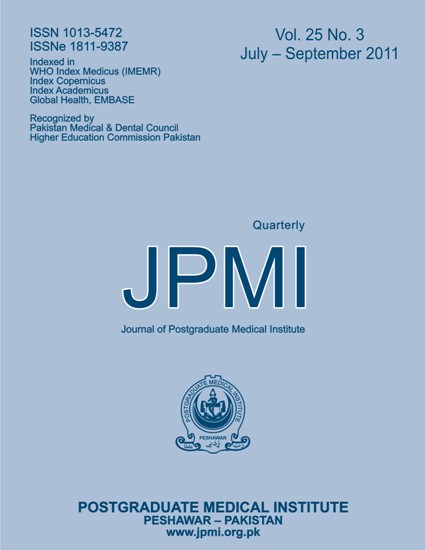ATHEROSCLEROTIC LESIONS IN CIGARETTE SMOKERS AND HUKKA SMOKERS: A COMPARATIVE HUMAN AUTOPSY STUDY
Main Article Content
Abstract
Objective: To assess the different morphological types of atherosclerotic lesions in cigarette smokers andHukka smokers in our population.Methodology: This descriptive study was conducted at the mortuary of King Edward Medical UniversityLahore and Department of Pathology Allama Iqbal Medical College Lahore from June 2007 to July 2009.Heart, aorta coronary arteries and renal arteries were collected from dead bodies. One to four areas oftissue were taken from aorta and each artery in all cases. Sections were prepared from paraffin blocks.These were stained with Haematoxylin and Eosin stain. Special stains were also performed to differentiateall the components of atherosclerotic lesions.Results: A total of 130 human autopsies were carried out in this study. Out of these, 84 were smokers (62cigarette and 22 hukka somkers). The analysis was carried out on these 84 cases. The mean age ofsmokers was 48.63+16.079. Fibrolipid plaques and complicated/ calcified lesions were seen inpredominantly more cases in cigarette smokers, than hukka smokers in aorta, coronary arteries and renalarteries.Conclusion: This study shows distribution of different atherosclerotic lesions in cigarette smokers andhukka smokers in our population. The raised atherosclerotic involvement in cigarette smokers as comparedto hukka smokers is evident from the results.
Article Details
How to Cite
1.
Naeem A. ATHEROSCLEROTIC LESIONS IN CIGARETTE SMOKERS AND HUKKA SMOKERS: A COMPARATIVE HUMAN AUTOPSY STUDY. J Postgrad Med Inst [Internet]. 2011 Oct. 14 [cited 2025 Dec. 5];25(3). Available from: https://jpmi.org.pk/index.php/jpmi/article/view/1160
Issue
Section
Original Article
Work published in JPMI is licensed under a
Creative Commons Attribution-NonCommercial 2.0 Generic License.
Authors are permitted and encouraged to post their work online (e.g., in institutional repositories or on their website) prior to and during the submission process, as it can lead to productive exchanges, as well as earlier and greater citation of published work.


